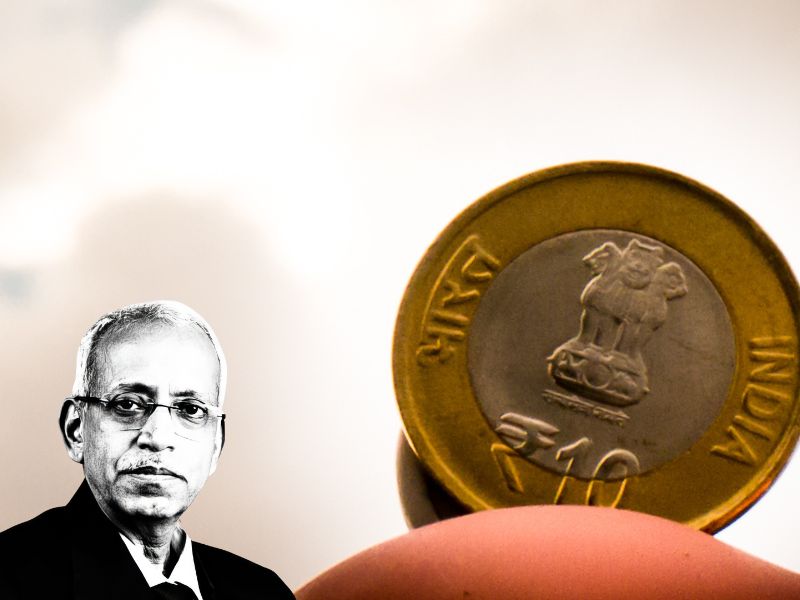.png)

Kalyan Ram, a financial journalist, co-founded Cogencis and now leads BasisPoint Insight.
February 22, 2025 at 7:43 AM IST
In the first part of this interview, G. Mahalingam outlined the real drivers of the rupee’s depreciation, arguing that it is less about domestic weakness and more about delayed adjustments to global dollar strength. He explained how the RBI’s past reluctance to let the rupee adjust naturally created pent-up pressure, now unwinding rapidly. While a gradual depreciation wouldn’t be a major concern, a sharp fall to 90–92 a dollar within weeks could create severe disruptions for importers and external borrowers who haven’t hedged their exposures.
Mahalingam dissected the RBI’s intervention strategy, highlighting how the 90-per-dollar level became a critical psychological barrier. He explained why the central bank stepped in aggressively before it was breached, fearing that unchecked depreciation would trigger a self-fulfilling speculative attack. He also detailed how traders watch for patterns in RBI behaviour, taking advantage of predictable intervention points.
The conversation also touched on the limits of RBI control. While the central bank can smoothen volatility, it cannot permanently dictate the rupee’s value. The key is to balance intervention with unpredictability, ensuring that markets remain cautious about pushing the rupee too far in either direction.
In this final instalment, Mahalingam expands on the RBI’s foray into the NDF market, the risks of taking on offshore speculators, and what he would advise the current RBI leadership on navigating these challenges.
The RBI has recently started intervening in the non-deliverable forward market. How does this compare to its interventions in the spot and forward markets, and what are the risks involved?
The NDF market is a different beast altogether. Unlike the domestic forex market, where the RBI has direct control, the NDF market is offshore—operating in major financial hubs like Singapore, London, and New York. Historically, this market was dominated by global hedge funds, foreign banks, and institutional investors, making it highly speculative and outside RBI jurisdiction.
The problem with ignoring the NDF market is that it often dictates the onshore rupee’s direction. Since large foreign investors hedge their Indian exposures offshore, sharp rupee movements in the NDF market create arbitrage opportunities, influencing the onshore exchange rate. If speculators start aggressively shorting the rupee offshore, it can spill over into domestic markets, forcing the RBI to intervene later at greater cost.
By stepping into the NDF market, the RBI isn’t just reacting—it’s trying to pre-empt speculation at the source. This is a smart tactical move, but it comes with significant risks.
Unlike in the domestic forex market, where the RBI can physically supply or absorb dollars, NDF trades are settled in cash—meaning the RBI only pays or receives the difference between contract prices. This means the RBI’s ability to exert real influence depends more on market psychology than sheer financial firepower.
The biggest risk here is miscalculation. The NDF market players are far more sophisticated, leveraged, and deep-pocketed than many domestic traders. If they sense predictability in RBI intervention, they will test the central bank’s resolve, placing larger bets against the rupee. If the RBI suffers heavy losses on its NDF positions, it could be forced to pull back, and that would send a strong bearish signal, potentially accelerating rupee depreciation.
To be effective, RBI must adopt a highly unpredictable and dynamic approach, ensuring that it doesn’t become a target for speculative attacks. Simply intervening at certain price points won’t work—the RBI must be able to shift sentiment, bluff when necessary, and know when to step back without signalling weakness.
If the RBI is drawn into a prolonged battle in the NDF market, could it end up weakening its own reserves position?
That’s the real danger. Intervening in NDF markets carries lower immediate costs than defending the rupee in the domestic spot market, but if the RBI is forced into a prolonged engagement, it could still take a serious hit.
In the domestic market, the RBI can intervene by selling dollars directly from its reserves, but in NDF, it takes on derivative positions. If market sentiment turns decisively against the rupee, the RBI might be forced to unwind these positions at a loss, affecting its overall financial standing.
Another major concern is that if traders see the RBI incurring losses on its forward book, it can embolden speculators further, making them more aggressive in shorting the rupee. This is where the RBI’s communication strategy becomes critical—it must ensure that intervention is seen as strategic and controlled, not as a panicked response to market pressure.
What would your advice be to the current RBI leadership in handling both onshore and offshore rupee pressures?
The RBI needs to approach this as a long game, not just a series of short-term tactical battles. Here’s what I would advise:
- Don’t overcommit to defending a particular level – Markets always test central banks when they sense rigid intervention patterns. The RBI must avoid the mistake of making 90 or any other round number a hard line in the sand. A gradual and unpredictable intervention pattern works better than a heavy-handed defense of arbitrary levels.
- Use a mix of tools – Instead of relying solely on dollar sales, the RBI should continue using forward contracts, swaps, and liquidity management to keep markets guessing. The more tools it employs, the harder for speculators to pin down a predictable RBI response.
- Maintain ambiguity in communication – One of the biggest mistakes a central bank can make is signalling too much. If traders know that the RBI will act at a certain level, they will trade against it. The RBI must retain some level of mystery about how aggressively it will defend the rupee, keeping the market cautious.
- Monitor the NDF market closely, but don’t get trapped in it – While NDF intervention is useful, the RBI must ensure it is not drawn into a prolonged battle where it is seen as playing defence against global speculators. If intervention fails to shift sentiment, the RBI must exit strategically rather than double down on a losing position.
- Prioritise the long-term health of the rupee over short-term optics – The exchange rate should be guided by macroeconomic fundamentals, not short-term market sentiment. If the rupee is headed towards a new equilibrium, resisting it artificially will only store up more volatility for later.
At the end of the day, the rupee will find its level. The RBI’s job is not to fix it at a specific rate, but to manage the transition without market panic.
One obvious question for anyone dealing with foreign exchange—where do you think the rupee will stabilise in the near term? Given the Fed’s stance and the global trade environment, what’s a reasonable expectation for the next six months? Where do you think the RBI would be comfortable allowing the rupee to settle?
Predicting the rupee’s exact trajectory is difficult because multiple forces influence its movement simultaneously—domestic fundamentals, global risk sentiment, US Federal Reserve policy, oil prices, and India’s external balance. However, by looking at historical patterns and current fundamentals, we can form a reasonable expectation.
The rupee has never moved in a straight line—it adjusts in sharp bursts rather than gradual, steady declines. If we examine previous depreciation cycles—whether it was the rupee moving from 31 to 37, then to 43, then to 50–55, and later to 68 during Raghuram Rajan’s tenure—each of these shifts happened in sudden phases rather than slow drifts.
Based on this historical pattern, and assuming the dollar index remains strong with no significant easing by the Fed, the rupee could be headed towards 90–91 over the next six months. This is where it may temporarily stabilise, provided external conditions do not deteriorate further.
You welcomed the RBI’s recent rate cut, but some argue that monetary policy is more effective when it works countercyclically. Given that fiscal policy has been tight and the government appears to be leaning on the RBI to support growth, do you think this reliance on monetary easing will be effective?
This is a crucial debate. I agree that relying solely on monetary policy to revive growth is unlikely to succeed. However, we also need to consider the government’s fiscal constraints and strategy before passing judgment.
The government does not want to go overboard on fiscal expansion, fearing that excessive spending could derail its fiscal consolidation path. Instead, it is trying to nudge the private sector into stepping up capital investment. But this has created a chicken-and-egg situation—the private sector wants the government to spend more first before committing, while the government is holding back, waiting for private investment to pick up.
To balance this, the government has allocated some capital expenditure, but not to the extent the market had hoped. It remains cautious, prioritising fiscal prudence over aggressive spending. A key factor behind this approach is India’s sovereign credit rating. Rating agencies closely monitor the fiscal deficit, and the government believes that if it stays on track with fiscal correction, India could eventually secure a credit rating upgrade. Such an upgrade could unlock new foreign capital flows, providing a structural boost to growth.
Given these constraints, the government is leveraging whatever flexibility it has on the monetary policy front. If the RBI has room to cut rates without risking inflation, the government sees that as a preferable option to large-scale fiscal expansion. This is a very delicate balancing act—the government is trying to support growth without compromising fiscal discipline, while the RBI is expected to ease policy within its inflation mandate.
Given these trade-offs, do you think the RBI has more room for monetary easing in the coming months?
The RBI’s ability to cut rates further will depend entirely on incoming inflation data. If inflation shows clear signs of softening, the RBI will have more space to lower rates and provide additional support to the economy. However, if price pressures persist, the central bank’s hands will be tied.
That said, market psychology also plays a role. Even if the RBI doesn’t cut rates aggressively, a change in its policy stance or forward guidance can have a significant impact on sentiment and liquidity conditions. Sometimes, just signalling an intention to ease in the future can influence market behaviour, encouraging credit expansion and investment activity.
Mr. Mahalingam, thank you for your time and for sharing such valuable insights.
Mahalingam: Very good questions. Thank you.
This completes the two-part interview with G. Mahalingam. His insights provide a rare behind-the-scenes perspective on RBI’s currency management strategy, its tactical choices in the NDF market, and the delicate balance between intervention and letting market forces play out.
Also read: Understanding the Rupee’s Fall With Veteran Regulator Mahalingam




